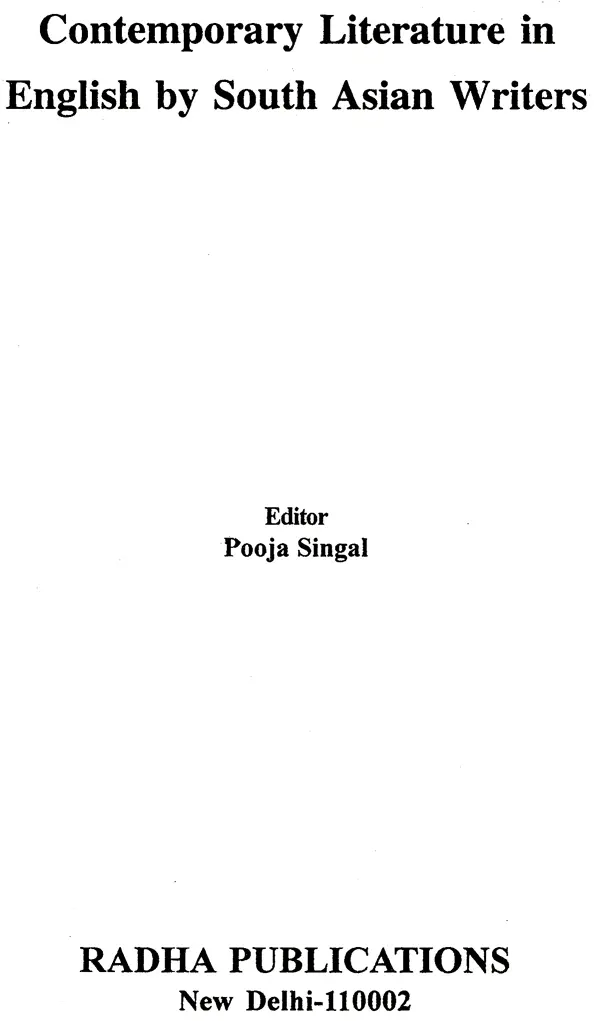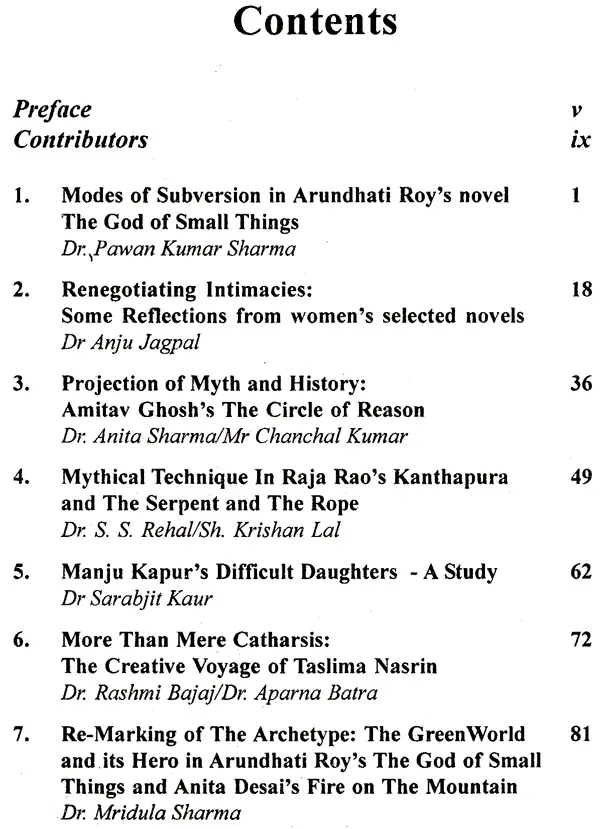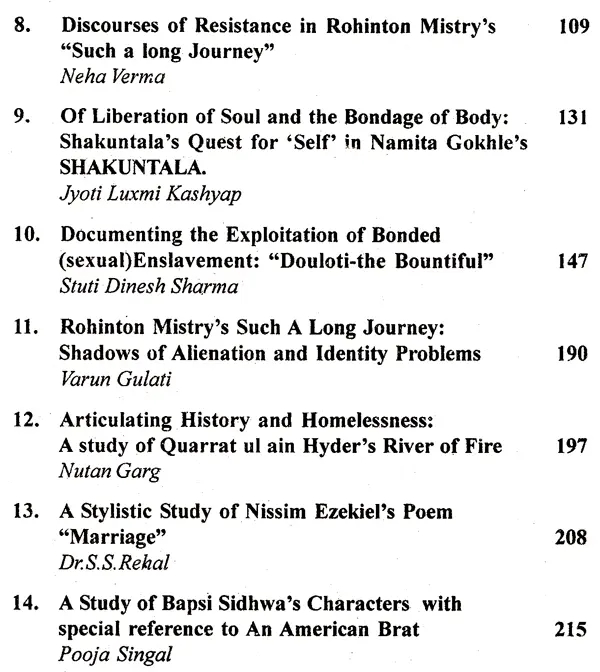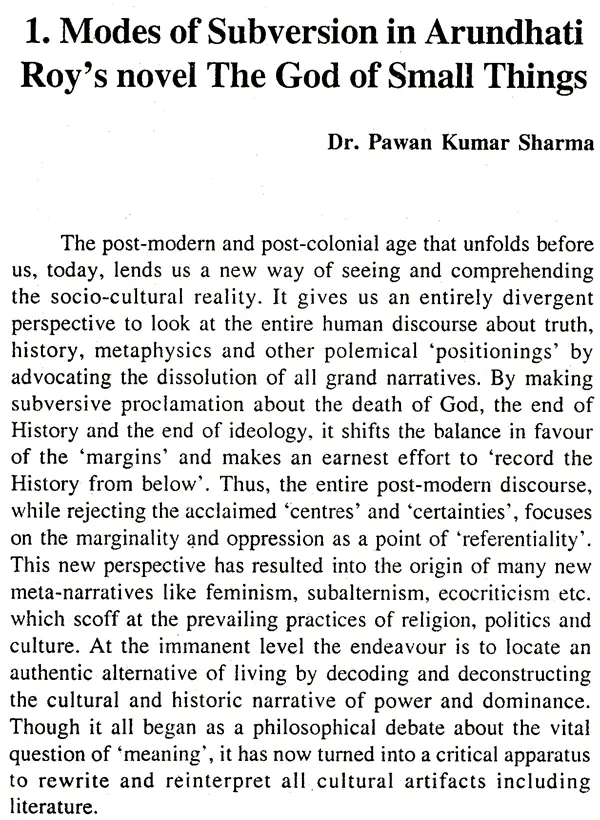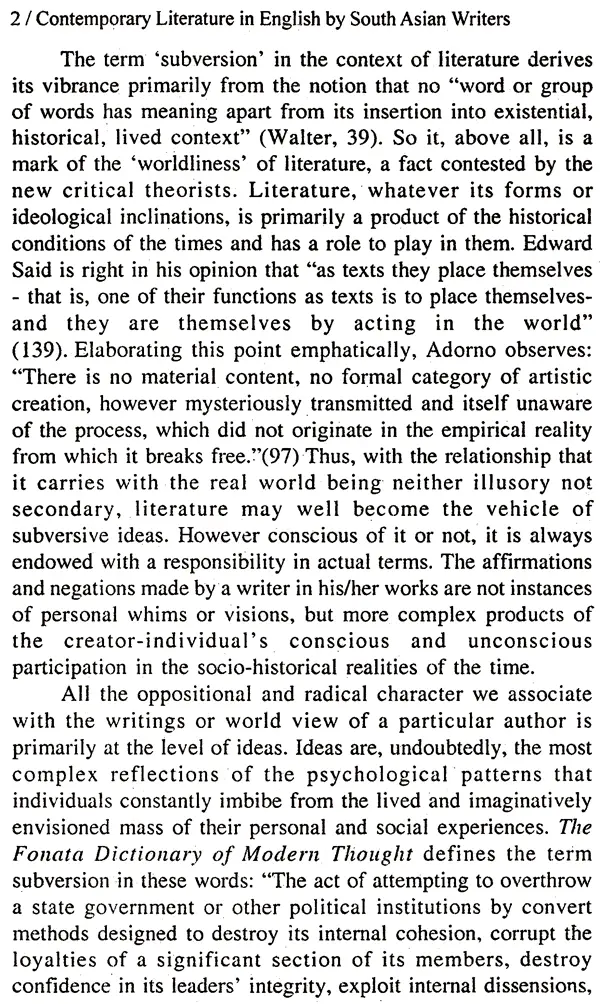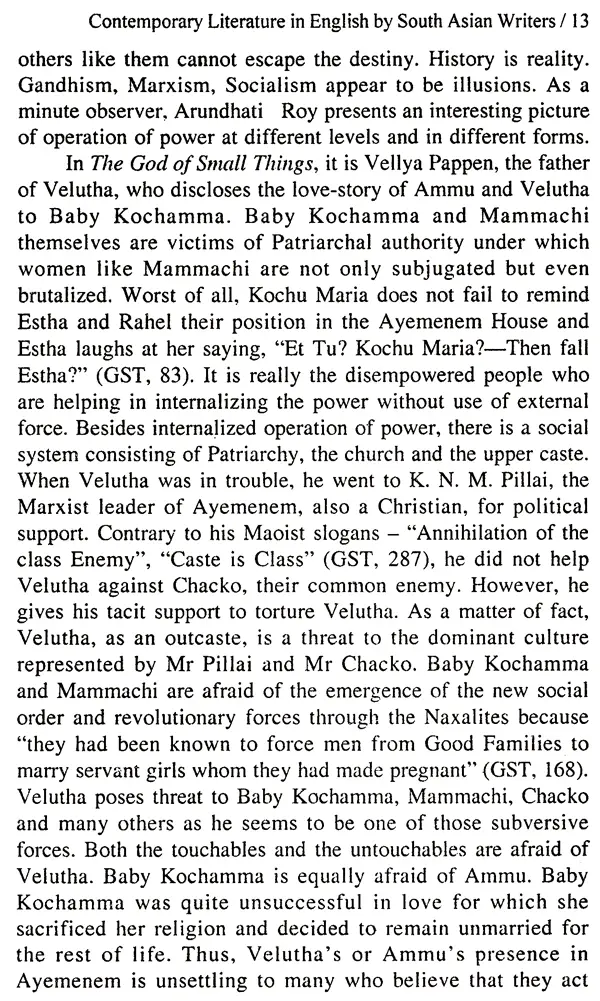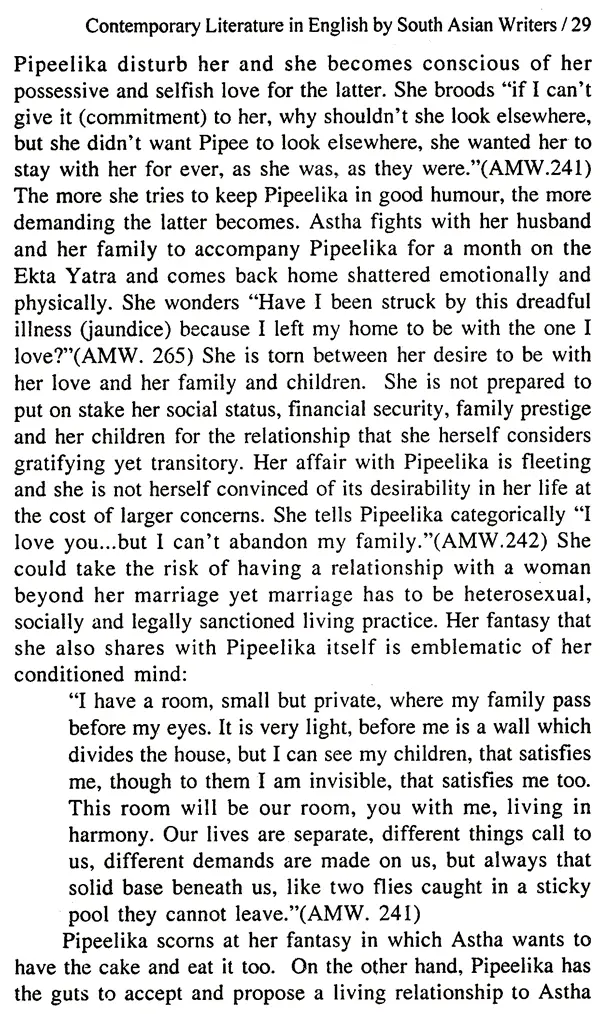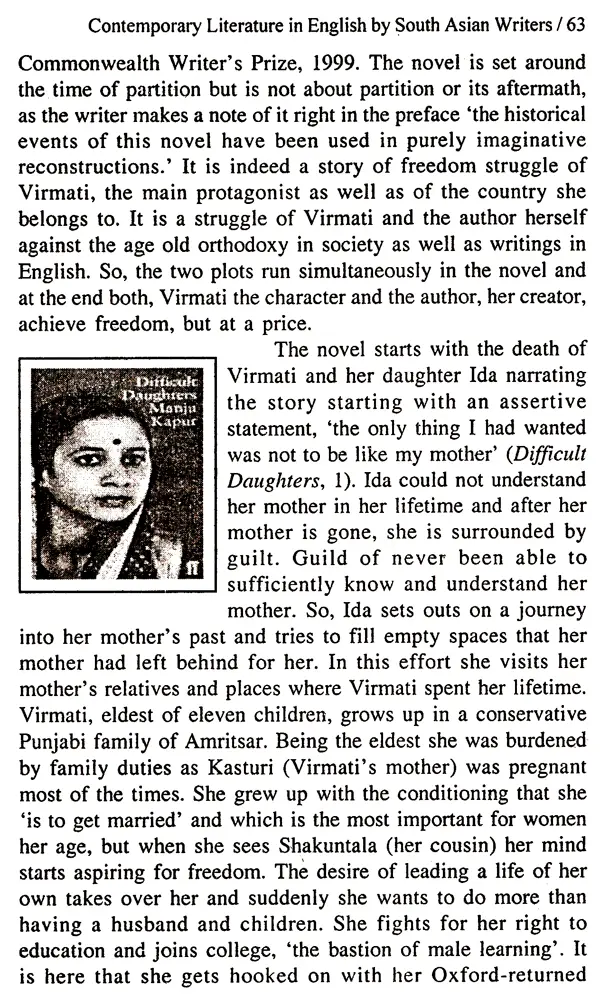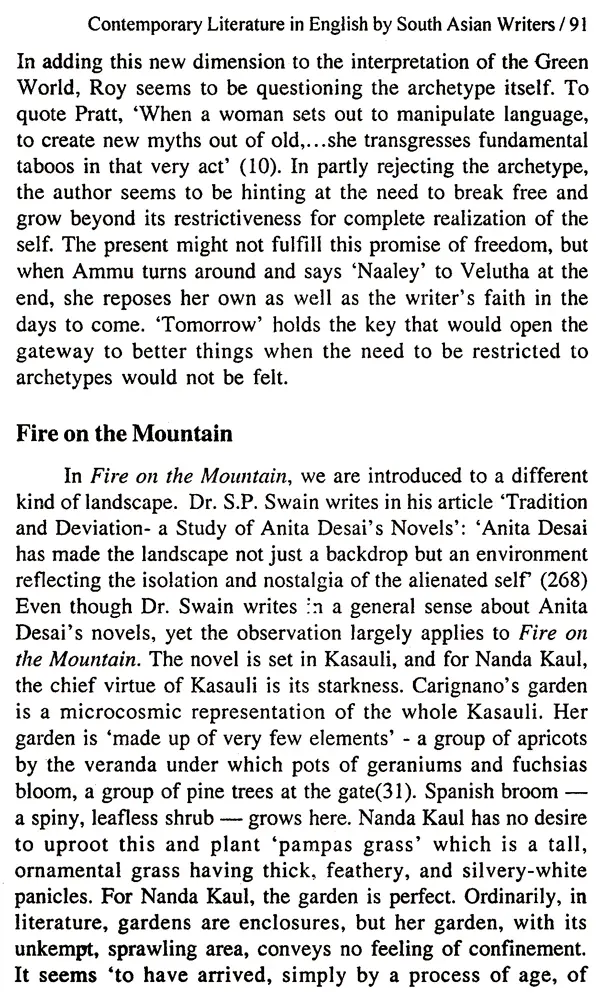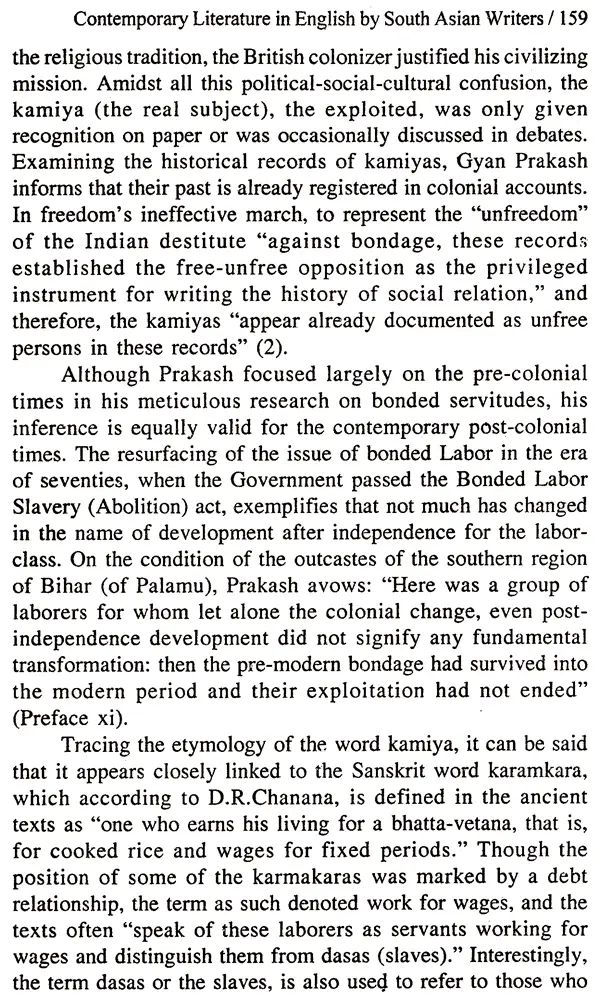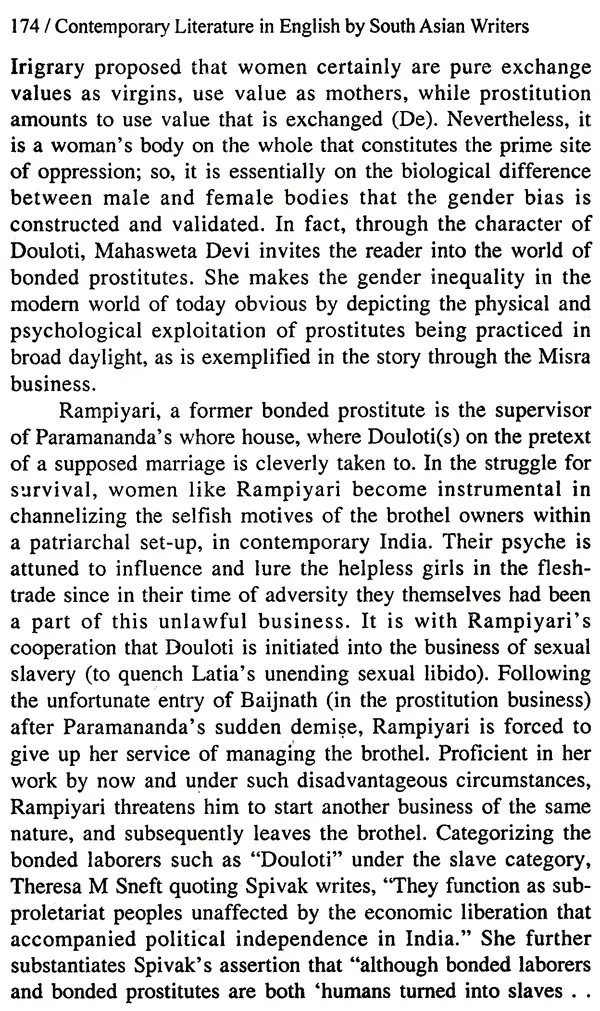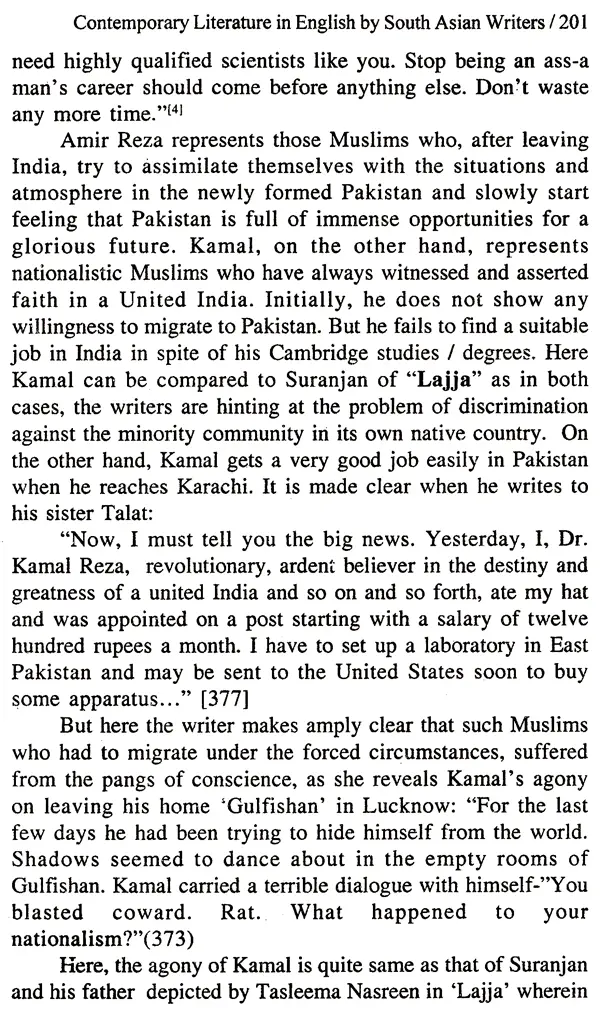
Contemporary Literature in English by South Asian Writers
Book Specification
| Item Code: | UAR420 |
| Author: | Pooja Singal |
| Publisher: | Radha Publications, Delhi |
| Language: | English |
| Edition: | 2011 |
| ISBN: | 9788174877277 |
| Pages: | 235 |
| Cover: | HARDCOVER |
| Other Details | 9.00 X 6.00 inch |
| Weight | 400 gm |
Book Description
South Asian literature in English is growing and trying to carve a niche for itself in the post modern literary world. It is being read and taught in various universities all round the globe. The contemporary south Asian writers in English generally deal with the themes of disintegration, deconstruction, cultural studies, multiculturalism and most importantly feminism. The present book contains scholarly papers related to some of the major post colonial writers and their themes, contributed by teachers and scholars of literature in English. Dr Pawan Kumar Sharma has traced the Modes of Subversion in Arundhati Roy's novel The God of Small Things. Dr Anju Jagpal in her paper Renegotiating Intimacies: Some Reflections from women's selected novels talks about the homosexual relations as presented in various contemporary novels. Dr Anita Sharma and Mr Chanchal Kumar have studied the Projection of Myth and History in Amitav Ghosh's The Circle of Reason. Mythical technique in Raja Rao's novels Kanthapura and The Serpant and the Rope has been analysed by Prof S S Rehal and Mr Krishan Lal in their scholarly paper. Dr Rehal has also contributed a critical paper on the stylistic study of Nissim Ezekiel's poem 'Marriage'. Dr Sarabjit Kaur presents an in depth study of the characters and the language used by Manju Kapoor in Difficult Daughters. Dr Rashmi Bajaj and Dr Aparna Batra have given an intelligent thesis on identity crisis as dealt with by Taslima Nasreen in Lajja and The French Lover. Dr Mridula Sharma in her paper, deals with tracing the occurrence of the Green World archetype in the context Arundhati Roy's The God of Small Things, a Anita Desai's Fire on the Mountain. Ms Neha Verma discusses the Discourses of Resistance in Rohinton Mistry's novel "Such a long Journey". Ms Jyoti Luxmi Kashyap has taken up the Quest for 'Self' in Namita Gokhle's Shakuntala as the topic of her paper. Ms Stuti Dinesh Sharma has interpreted on various levels, the sexual exploitation as documented by Mahashweta Devi in Douloti - the Bountiful. Mr Varun Gulati studies the shadows of alienation. in his paper about Rohinton Mistry. Ms Nutan Garg has taken up the study of homelessness and history in Quarrat ul ain Hyder. The editor Ms Pooja Singal has studied the characters as delineated by Pakistani Parsee writer Bapsi Sidhwa in her novel An American Brat. It is hoped that the book will prove to be informative and useful to the teachers and scholars of English Literature particularly those who focus on the writers of Indian, Bangladeshi, Pakistani, Sri Lankan, Nepalese and Bhutan origin writing in English.
Pooja Singal is an Assistant Professor in the Dept of English at Govt PG College Naraingarh, Dist Ambala (Haryana). She writes papers for various journals and is a life member of some important literary associations. She is an alumna of Kurukshetra University Kurukshetra. She has a teaching experience of about 8 years.
The contemporary post colonial writers in English generally deal with the themes of disintegration, deconstruction, cultural studies, multiculturalism and most importantly feminism. The post colonial writers of those South- Asian countries which were formerly subjugated and were under the colonial empires are now coming out with literary expression of their political and cultural independence. The major themes are no doubt, common and recurring, but the treatment of these themes is unique and bears the stamp of the writers' character and personality. So, any two books with the same theme may be totally different in their appeal to the reader. In case of the writers of Indian, Bangladeshi and Pakistani origin, another prominent theme is that of partition of the subcontinent and its terrible aftermaths, both physical and psychological. The related sub themes include alienation, rootless ness, identity crisis, historical documentation, and cultural heritage. It is noteworthy that the writers born after independence do not attach any colonial associations with English language and use it as a powerful, comfortable and universally used medium of expression. They give an authentic presentation of contemporary India with its regional variations. These writers generally write about urban middle class society which they are most familiar with. They deal with various new themes like magic realism, dystopian picture of modern India, college life, existential predicaments, and migration to west for education and career and so on. The Sri Lankan writers like Romesh Gunesekra, Michael Ondaatje, Shyam Selvadurai, Ameena Hussain and Jayashanta Jayavardhana deal with the political themes apart from the common ones, as the beautiful island has been torn by political tribulations for long. The major writers of the Indian origin like, Amitav Ghosh, Arundhati Roy, Anita Desai, Manju Kapoor, Geeta Mehta, Chitra B Divakaruni, Jhumpa Lahiri, Shashi Deshpande, V S Naipaul, Namita Gokhale, Anita Nair, and Aravind Adiga have taken up philosophical, political, cultural and social subjects for their novels. The refugee status of the unfortunate people who had to leave their own land and inhabit new countries after partition, their severe identity crisis, the denial of acceptance by original inhabitants of the new countries, the feeling of homelessness, and cultural crisis find a vivid expression in the post modern, post colonial literature of South Asian countries. Poets and writers like Mahasweta Devi and Quarrat ul ain Hyder, are being translated into various languages, particularly English, and read all over the world. Their popularity is in no way lesser than the writers writing originally in English, because of their deep thought and sensibility which finds a vivid expression in their work.
The literature of the three fragments of one large nation is as similar to one another as it is different. Bangladeshi writers in English like Taslima Nasreen, Monika Ali, Tahmina Aman, and Kaiser Haq portray characters that suffer because of their minority status and feel frustrated when they are discriminated against just because they have their roots in the other fragment. Bangladeshi writers focus on the quest for identity and conflicts within and without the self. The struggle against minority crisis, religion crisis and language crisis is long and is still going on. This theme is also dealt with at large by the Pakistani writers like Zulfikar Ghose, Hanif Kureishi, Talat Abbasi, Moniza Alvi, Kamila Shamsie, Nadeem Aslam and others. They write about the to establish new and secular customs which should replace the old and suffocating traditions. Distinguished Pakistani women writers like Tehmina Durrani, and Tahira Naqvi, are also doing their bit very actively. In the conservative social set up of Pakistan, sharp reactions are received when women try to break the existing crass conventions. Some upcoming writers like Manjushree Thapa of Nepal and Kunzang Choden of Bhutan are dealing with similar themes. Through both genres, novel and poetry, the women writers of all South Asian countries have explored female issues in order to establish their own identity which is free from the traditional roles assigned by the patriarchal society. They are grappling with gender crisis and deem to register their sexual identity in the male dominated hostile society. The most conspicuous literary output today is coming from the Parsee writers from all over the world. Major Indian Parsee writers Rohinton Mistry and Farrukh Dhondy are obsessed with their minority status, as the total world population of the Parsees is only in lakhs. The expression of the unique sensibilities of the Parsees needs a little extra attention. They have a compulsive impulse to portray Parsee characters, their rituals, customs and the obscure Zoroastrian culture. The famous Pakistani Parsee woman writer Bapsi Sidhwa portrays Parsee men and women as highly adaptable to their surroundings though clinging with conviction to their own faith, and resisting any intrusions. The Parsees are generally portrayed as elite, well- educated, and accomplished. The present book contains scholarly papers related to some of the above mentioned writers, poets and themes, contributed by teachers and scholars of literature in English, well placed in various colleges and universities across northern India. The papers are a result of deep reading and intelligent interpretation of various literary compositions by south Asian writers. The major post colonial and post modern themes and trends have been traced by all the contributors in their papers. I thankfully acknowledge the effort put in by all of them in sharing their papers as well as their quick and enthusiastic response to all quarries.
**Contents and Sample Pages**
